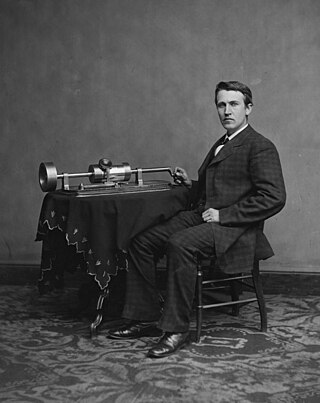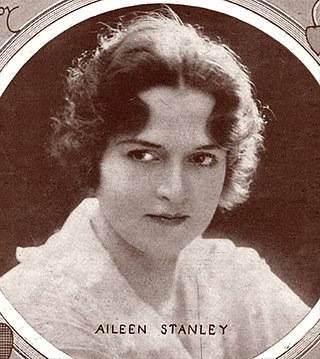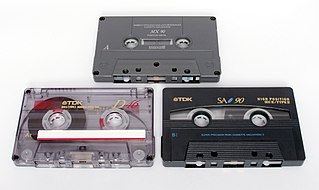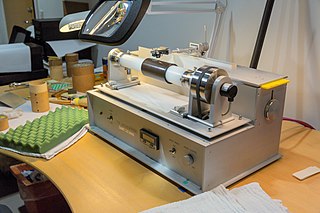The Cylinder Audio Archive is a free digital collection maintained by the University of California, Santa Barbara Library with streaming and downloadable versions of over 10,000 phonograph cylinders manufactured between 1893 and the mid-1920s. The Archive began in November 2003 as the successor of the earlier Cylinder Preservation and Digitization Pilot Project.
The pilot project began in 2002 to test the feasibility of digitizing cylinder recordings on a large scale for preservation and public access and explore issues related to the preservation and digitization of cylinder records. In 2003, the Institute for Museum and Library Services funded the Archive with a grant for $205,000 and between 2003 and 2005 UCSB library staff cataloged and digitized over 6,000 of the cylinder recordings in the library's collection using an archéophone, a modern electrical cylinder player designed in France by Henri Chamoux. The website was released to the public on November 16, 2005. Since outside project funding has ended a further 4,000 cylinders have been added to the archive.[ citation needed ]
The Archive consists of a broad range of cylinder records manufactured between 1893 and the mid-1920s. The majority were produced by Edison Records in Orange, New Jersey, but the Archive also contains cylinders produced by the Columbia Phonograph Co., Indestructible Records and other companies. The majority of the cylinders feature music and include band recordings, popular songs, vaudeville, opera arias, and music for solo instruments such as banjo, violin and accordion, but the Archive also contains speeches, comedic monologues and home recordings.[ citation needed ]
The Archive currently holds only the cylinders in the collection of the UCSB Libraries. Other libraries, including the Library of Congress and Bowling Green State University, have contributed cylinders for preservation and digitization, as have private collectors. The Archive accepts donations of cylinders but at present does not add digital files of cylinders from other collections, the one exception being cylinders in the collection of John Levin.[ citation needed ]

A phonograph, in its later forms also called a gramophone or since the 1940s called a record player, or more recently a turntable, is a device for the mechanical and analogue recording and reproduction of sound. The sound vibration waveforms are recorded as corresponding physical deviations of a spiral groove engraved, etched, incised, or impressed into the surface of a rotating cylinder or disc, called a "record". To recreate the sound, the surface is similarly rotated while a playback stylus traces the groove and is therefore vibrated by it, very faintly reproducing the recorded sound. In early acoustic phonographs, the stylus vibrated a diaphragm which produced sound waves which were coupled to the open air through a flaring horn, or directly to the listener's ears through stethoscope-type earphones.

Phonograph cylinders are the earliest commercial medium for recording and reproducing sound. Commonly known simply as "records" in their era of greatest popularity, these hollow cylindrical objects have an audio recording engraved on the outside surface, which can be reproduced when they are played on a mechanical cylinder phonograph. In the 1910s, the competing disc record system triumphed in the marketplace to become the dominant commercial audio medium.
Events in the year 1891 in music.

The Victor Talking Machine Company was an American recording company and phonograph manufacturer that operated independently from 1901 until 1929, when it was acquired by the Radio Corporation of America and subsequently operated as a subsidiary called RCA Victor.

The Library of Congress National Digital Library Program (NDLP) is assembling a digital library of reproductions of primary source materials to support the study of the history and culture of the United States. Begun in 1995 after a five-year pilot project, the program began digitizing selected collections of Library of Congress archival materials that chronicle the nation's rich cultural heritage. In order to reproduce collections of books, pamphlets, motion pictures, manuscripts and sound recordings, the Library has created a wide array of digital entities: bitonal document images, grayscale and color pictorial images, digital video and audio, and searchable e-texts. To provide access to the reproductions, the project developed a range of descriptive elements: bibliographic records, finding aids, and introductory texts and programs, as well as indexing the full texts for certain types of content.

Blue Amberol Records was the trademark name for cylinder records manufactured by Thomas A. Edison, Inc. in the US from 1912 to 1929. They replaced the 4-minute black wax Amberol cylinders introduced in 1908, which had replaced the 2-minute wax cylinders that had been the standard format since the late 1880s. Blue Amberols can play for as long as 4 minutes and 45 seconds and have a surface layer of the "indestructible" plastic celluloid, which Edison tinted a trademark blue color. Edison brand phonographs designed to play Amberol cylinders were named Amberolas.

Aileen Stanley, born Maude Elsie Aileen Muggeridge, was one of the most popular American singers of the early 1920s.

Digitization is the process of converting information into a digital format. The result is the representation of an object, image, sound, document, or signal obtained by generating a series of numbers that describe a discrete set of points or samples. The result is called digital representation or, more specifically, a digital image, for the object, and digital form, for the signal. In modern practice, the digitized data is in the form of binary numbers, which facilitates processing by digital computers and other operations, but digitizing simply means "the conversion of analog source material into a numerical format"; the decimal or any other number system can be used instead.

American Memory is an internet-based archive for public domain image resources, as well as audio, video, and archived Web content. Published by the Library of Congress, the archive launched on October 13, 1994, after $13 million was raised in private donations.

Sound recording and reproduction is the electrical, mechanical, electronic, or digital inscription and re-creation of sound waves, such as spoken voice, singing, instrumental music, or sound effects. The two main classes of sound recording technology are analog recording and digital recording.
Audio restoration is the process of removing imperfections from sound recordings. Audio restoration can be performed directly on the recording medium, or on a digital representation of the recording using a computer. Record restoration is a particular form of audio restoration that seeks to repair the sound of damaged gramophone records.

Preservation of magnetic audiotape comprises techniques for handling, cleaning and storage of magnetic audiotapes in an archival repository. Multiple types of magnetic media exist but are mainly in the form of open reels or enclosed cassettes. Although digitization of materials on fragile magnetic media in library and information science is a common practice, there remains a need for conserving the actual physical magnetic tape and playback equipment as artifacts.

The conservation and restoration of vinyl discs refers to the preventive measures taken to defend against damage and slow degradation, and to maintain fidelity of singles, 12" singles, EP’s, and LP’s in 45 or 33⅓ rpm 10” disc recordings.
Oral history preservation is the field that deals with the care and upkeep of oral history materials, whatever format they may be in. Oral history is a method of historical documentation, using interviews with living survivors of the time being investigated. Oral history often touches on topics scarcely touched on by written documents, and by doing so, fills in the gaps of records that make up early historical documents.

The Archéophone is a modern, electric version of the phonographs and ediphones from the 19th and early 20th century. It is specifically designed to transfer phonograph cylinders and other cylinder formats to modern recording media.

BBC Archives are collections documenting the BBC's broadcasting history, including copies of television and radio broadcasts, internal documents, photographs, online content, sheet music, commercially available music, BBC products, press cuttings, artifacts and historic equipment. The original contents of the collections are permanently retained but are in the process of being digitised. Some collections are being uploaded to the BBC Archives section of the BBC Online website for visitors to view. The archive is one of the largest broadcast archives in the world, with over 15 million items.
The Great 78 Project is an initiative developed by the Internet Archive which aims to digitize 250,000 78 rpm singles from the period between 1880 and 1960, donated by various collectors and institutions. The project has been developed in collaboration with the ARChive of Contemporary Music and George Blood Audio, responsible for the audio digitization. The project is curated by B. George, director of the ARChive of Contemporary Music. The goal of the initiative is not to remaster or enhance the original recordings, but to present them as "historical artifacts". The majority of the 78 rpm records being digitized have never existed in any other form.

The Indiana University Archives of Traditional Music holds over 100,000 individual audio and video recordings across over 3500 collections of field, broadcast, and commercial recordings. Its holdings are primarily focused on audiovisual recordings relating to research in the academic disciplines of ethnomusicology, folklore, anthropology, linguistics, and various area studies.

Coon, Coon, Coon is a "coon song" from 1900. The words were written by Gene Jefferson and the music by Leo Friedman. The lyrics are about an African American concerned with his appearance including his skin color and hair type while not being accepted by a woman. He makes efforts to acquire Caucasian characteristics but fails and is called out. Songsheet cover for the music include caricatured African American faces and a photograph of minstrel performers of the song inset.
The Discography of American Historical Recordings (DAHR) is a database of master recordings made by American record companies during the 78rpm era. The DAHR provides some of these original recordings, free of charge, via audio streaming, along with access to the production catalogs of those same companies. DAHR is part of the American Discography Project (ADP), and is funded and operated in partnership by the University of California, Santa Barbara, the National Endowment for the Humanities, and the Packard Humanities Institute.